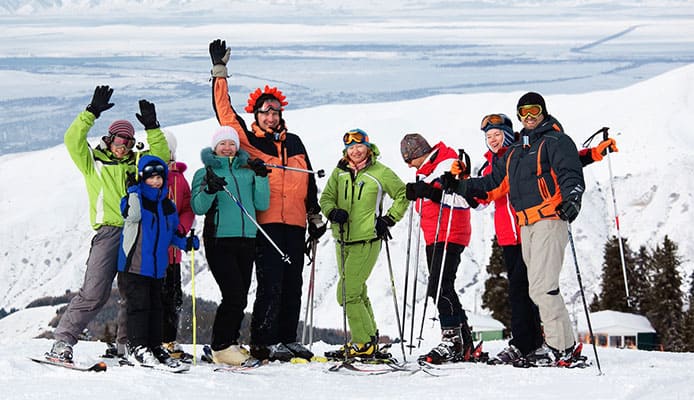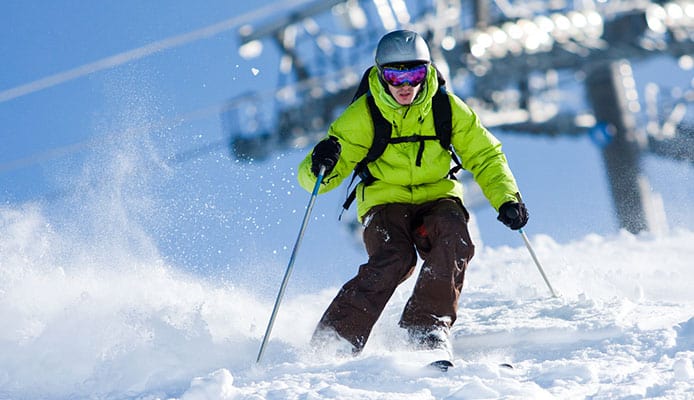
For the ski enthusiast, perhaps the most important piece of gear next to ski boots and ski socks are of course the skis. When you are out shopping for a pair, you need to make sure that they fit right and that they offer you the performance you are looking for. This will often come down to your method of skiing.
You will also need to choose between short skis vs long skis. And no, the right length for you doesn’t necessarily depend on your height and weight.
The main difference between short skis and long skis is that short skis have a smaller turning radius and are a bit slower while long skis have a larger turning radius and are much faster.
Let’s find out more about the difference between long skis vs short skis.
Picking the right size ski
The right ski length for you will depend to a large extent on your preferred method of skiing. Generally, however, you might go for an ideal length between your chin and the top of your head when standing up straight and holding the ski perpendicular to your body.
Short skis
One of the differences between long skis vs short skis is that the short skis have a much smaller turning radius. This allows you to make much sharper turns. Keep in mind however that this may not always be a good thing depending on the terrain.
Secondly, they are quick to respond to your movement as the energy you send to your legs has a short distance to travel.
Ensure that you are wearing the best ski helmet to keep your eyes and face well-protected.
If you are skiing on hard snow, the short skis are lighter and will perform much better. Note that this is not always the case with very short skis.
Thanks to their much easier control the short skis are ideal for beginners. Also, if your age is catching up and your reflexes and your fitness levels are dropping, then shorter skis will make it easier for you.
For people who prefer skiing down at lower speeds and those who are not aggressive at their skiing, then shorter skis are a great choice.
That said, shorter skis come with their fair share of disadvantages.
Since the shorter skis make much sharper turns, you are more likely to sprain a ligament and have knee and ankle injuries.
They are also less stable since only a smaller area is in contact with the snow.
Also, they will not float on powder as well as longer skis can. This makes it difficult to ski in this type of terrain.
Long skis
Since there is more surface area in contact with the snow, longer skis are much better when on powdery snow. They float much easier than shorter skis. Learn how to break new ski boots before heading out onto the snowy slopes.
Also, due to the larger surface area with the snow, they are more stable than the shorter skis.
They have a much larger S turn and while this might sound like a bad thing, it is a good thing when on powdery snow.
When deciding between long skis vs short skis, you may opt for the longer skis if you prefer skiing at speed. If you are one for more aggressive skiing, then longer skis are the better option.
However, longer skis do come with their own set of cons
If you are skiing on steep terrain, navigation is not easy owing to the larger turning area of the longer skis.
Since they are large, they are also heavy which means more effort is required to turn the skis and they are not as responsive as shorter skis.
Ski boards
Ski boards are every short ski. They are also known as ski blades and many skiers will have great fun practicing stunts on them.
They are not the best for ice or powdery snow but compact snow can provide you with one fun-filled day.
You might also like: Top Base Layers For Skiing
Ski length and speed

When the skis are pointed downhill, longer skills will be faster than shorter skis. Since they have a larger surface area, the longer skis distribute more weight and therefore have less pressure on them. There is also less capillary drag and this is why they are faster.
Note that we are not saying that shorter skis cannot move faster. Longer skis will also have fewer vibrations compared to shorter skis which makes them much more comfortable when moving at speed.
To maximize your speed, pick a longer ski that also much firmer. This will keep the weight on the ski without it being bent and creating drag.
An important skill to have is how to get up after a skiing fall.
Skis and height
If you are deciding on short skis vs long skis it will boil down to your level of experience. More experienced skiers will benefit from skis that are taller than them. They have fewer vibrations and will move much faster in the snow.
On the other hand, if you are not very experienced and you still want a pair of fast skis, go for the chin height. Much longer skis will be harder to control and heavy on the feet.
Skis and ease of control
The ease of control will depend on the speed. Longer skis are easier to control at high speeds as the turning radius is large and you are less likely to fall.
Shorter skis, on the other hand, are hard to control at high speeds due to their short turning radius. The opposite is also true.
To ensure that your body remains warm on the snow, consider the best base layers for skiing.
The ski boot
Getting the right size ski is just the first step. You also need to ensure that you get the right ski boot. It will help you keep your knees and ankles safe and transfer the energy to the skis.
With a poor-fitting ski boot, you will lose a lot of energy. Aim for a quality well-fitting and snug ski boot.
The downside of renting ski boots is that they are usually ideal for people with wider feet. Even while they may feel comfortable, they may be not ideal for people with narrow feet. It’s a good idea in this case to either try on different boots or buys a good pair that fits your feet just right.
Also, if you wear ski boots and you come out of your ski session feeling pain on the feet, then you likely chose the wrong boots. Even with the right boots, you may start to notice that they don’t fit as comfortably as they once did. In this case, you will need to change the inner liner and the boot should go back to normal.
Globo Surf Overview
Depending on the level of experience and type of snow conditions that you are skiing on, you will need to choose between short skis vs long skis. However, keep in mind that having a good pair of ski boots is crucial. Only then can you make the most of your time on those snowy slopes.
More Snow Ski Gear Guides:
- DIN Calculator: Guide On How To Calculate DIN Setting For Ski Bindings
- How To Remove Ski Bindings
- Do You Really Need Ski Goggles
- Ski vs Snowboard Clothing Guide
- How To Layer For Skiing
- How To Choose Ski and Snowboard Goggles
- How To Size Ski Poles

